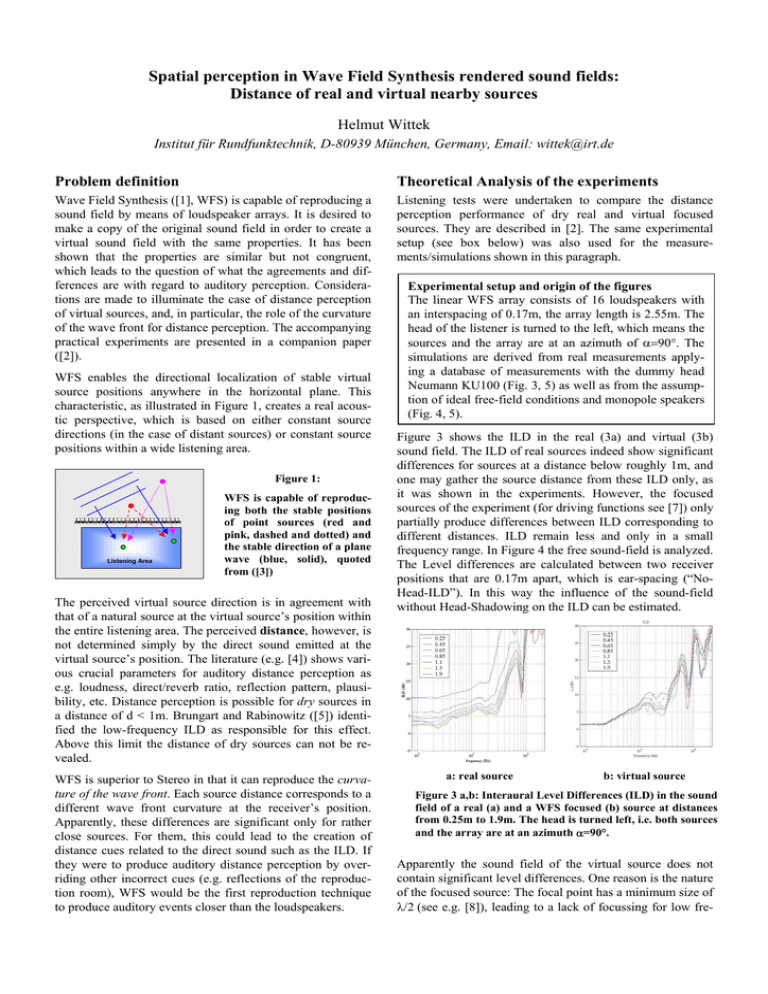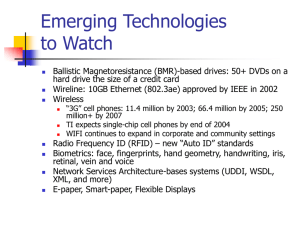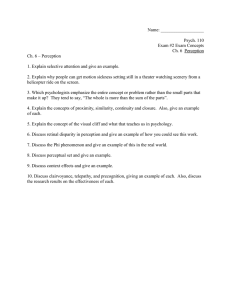Spatial perception in Wave Field Synthesis rendered sound fields
advertisement

Spatial perception in Wave Field Synthesis rendered sound fields: Distance of real and virtual nearby sources Helmut Wittek Institut für Rundfunktechnik, D-80939 München, Germany, Email: wittek@irt.de Problem definition Theoretical Analysis of the experiments Wave Field Synthesis ([1], WFS) is capable of reproducing a sound field by means of loudspeaker arrays. It is desired to make a copy of the original sound field in order to create a virtual sound field with the same properties. It has been shown that the properties are similar but not congruent, which leads to the question of what the agreements and differences are with regard to auditory perception. Considerations are made to illuminate the case of distance perception of virtual sources, and, in particular, the role of the curvature of the wave front for distance perception. The accompanying practical experiments are presented in a companion paper ([2]). Listening tests were undertaken to compare the distance perception performance of dry real and virtual focused sources. They are described in [2]. The same experimental setup (see box below) was also used for the measurements/simulations shown in this paragraph. WFS enables the directional localization of stable virtual source positions anywhere in the horizontal plane. This characteristic, as illustrated in Figure 1, creates a real acoustic perspective, which is based on either constant source directions (in the case of distant sources) or constant source positions within a wide listening area. Figure 1: Listening Area WFS is capable of reproducing both the stable positions of point sources (red and pink, dashed and dotted) and the stable direction of a plane wave (blue, solid), quoted from ([3]) The perceived virtual source direction is in agreement with that of a natural source at the virtual source’s position within the entire listening area. The perceived distance, however, is not determined simply by the direct sound emitted at the virtual source’s position. The literature (e.g. [4]) shows various crucial parameters for auditory distance perception as e.g. loudness, direct/reverb ratio, reflection pattern, plausibility, etc. Distance perception is possible for dry sources in a distance of d < 1m. Brungart and Rabinowitz ([5]) identified the low-frequency ILD as responsible for this effect. Above this limit the distance of dry sources can not be revealed. WFS is superior to Stereo in that it can reproduce the curvature of the wave front. Each source distance corresponds to a different wave front curvature at the receiver’s position. Apparently, these differences are significant only for rather close sources. For them, this could lead to the creation of distance cues related to the direct sound such as the ILD. If they were to produce auditory distance perception by overriding other incorrect cues (e.g. reflections of the reproduction room), WFS would be the first reproduction technique to produce auditory events closer than the loudspeakers. Experimental setup and origin of the figures The linear WFS array consists of 16 loudspeakers with an interspacing of 0.17m, the array length is 2.55m. The head of the listener is turned to the left, which means the sources and the array are at an azimuth of α=90°. The simulations are derived from real measurements applying a database of measurements with the dummy head Neumann KU100 (Fig. 3, 5) as well as from the assumption of ideal free-field conditions and monopole speakers (Fig. 4, 5). Figure 3 shows the ILD in the real (3a) and virtual (3b) sound field. The ILD of real sources indeed show significant differences for sources at a distance below roughly 1m, and one may gather the source distance from these ILD only, as it was shown in the experiments. However, the focused sources of the experiment (for driving functions see [7]) only partially produce differences between ILD corresponding to different distances. ILD remain less and only in a small frequency range. In Figure 4 the free sound-field is analyzed. The Level differences are calculated between two receiver positions that are 0.17m apart, which is ear-spacing (“NoHead-ILD”). In this way the influence of the sound-field without Head-Shadowing on the ILD can be estimated. a: real source b: virtual source Figure 3 a,b: Interaural Level Differences (ILD) in the sound field of a real (a) and a WFS focused (b) source at distances from 0.25m to 1.9m. The head is turned left, i.e. both sources and the array are at an azimuth α=90°. Apparently the sound field of the virtual source does not contain significant level differences. One reason is the nature of the focused source: The focal point has a minimum size of λ/2 (see e.g. [8]), leading to a lack of focussing for low fre- quencies. Whereas the frequency response at a certain reference distance can be equalized, a level difference cannot be changed through filtering. One other important property of a linear array in WFS is a deviation in the spatial amplitude decay of the virtual source (“Amplitude errors”, see [6]). The amplitude increase with decreasing distance to the focused source is smaller in comparison with the real case. act measurements, but this cannot be deduced from these simulations. It is interesting that the Head-Shadowing effect is, apart from the ripples, the same for all source distances. A comparison of Figures 5a and 5b reveals that it is the HeadShadowing of a real source in any distance of above 1m (the array distance was 1.25m). This creates speculations about the way in which Head Shadowing is reproduced in WFS. Conclusion The spatial properties of WFS focused sources, in particular with regard to distance perception, were theoretically considered. The results of listening tests described in a companion paper ([2]) could be explained. The effects of Head Shadowing, together with the physics of WFS focused sources were analyzed to gain an insight into the potential of WFS virtual focused sources to create a sense of distance. a: real source b: virtual source Figure 4 a,b: “No-Head-ILD” (Level differences between positions which are spaced according to ear-spacing) in the sound field of a real (a) and a WFS focused (b) source at distances from d=0.25m to 1.9m. The two positions are at distances of d +/- earspacing/2, corresponding to a head that is turned left. Head Shadowing The ILD is considered as a result of two different parameters: the level differences due to the different distances of the two ears to the source (“No-Head-ILD”) and the Head Shadowing (including Head diffraction and Pinna effects), leading to an increase of the “No-Head-ILD”. “HeadShadowing” causes frequency-dependent Level differences. It is a distance-dependant parameter for real sources (Fig. 5a). However, the differences are significant only for very close sources. For instance, at a distance of 0.45m the HeadShadowing effect creates a level difference that is up to 5 dB greater than at farther distances. It was found for the dry virtual sources of the experiment that both theory and experiments suggest that certain relevant cues for the perception of the distance are not existent. The study concentrated on dry sources which are in this case considered to explain the meaning of the direct sound (the first wave front) of a virtual source. The direct sound only partially offers auditory cues for distance perception. These cues are existent and relevant for dry real sources as shown in theory and practice. A way to overcome the described deficiency of WFS to produce ILD for distance perception is to apply natural acoustics to the virtual source. These additional cues can possibly make up the lack of binaural direct sound cues. However, disturbing reflections caused by the WFS array itself may hinder the perception of the distance of virtual sources in front of the array. Acknowledgments The study was done in collaboration with Stefan Kerber, Günther Theile and Francis Rumsey. Furthermore, many thanks to Rinus Boone, Tobias Neher and John Oag. References [1] Berkhout, A. J.; de Vries, D., 1993; Vogel, P: “Acoustic Control by Wave Field Synthesis,” J. Acoust. Soc. Am., Vol. 93, pp. 2764–2778. [2] S.Kerber: Experimental investigations into the distance perception of nearby sound sources: Real vs. WFS virtual nearby sources. Companion paper, CFA/DAGA 04, Strasbourg, March 2004. [3] Theile, G., Wittek, H., Reisinger, M., 2003: “Potential Wavefield Synthesis Applications in the Multichannel World”, Proc. AES 24th Int. Conference on Multichannel Audio, Banff, Canada [4] a: real source source b: virtual source Figure 5 a,b: “Head-Shadowing effect” in the sound field of a real (a) and a WFS focused (b) source at distances from 0.25m to 1.9m. Nielsen, S., 1991: “Distance Perception in Hearing”, Dissertation, Aalborg University Press, Aalborg, Denmark, ISBN 87-7307-447-0 [5] Brungart and Rabinowitz, 1999: „Auditory localization of nearby sources, I, II and III”, J. Acoust. Soc. Am., Vol. 106, No. 3,4 and 6. [6] Wittek, H., 2003: “Perception of Spatially synthesized sound fields – Literature In contrast to the real source, the Head-Shadowing effects of the virtual sources (Fig.5b) show nearly no dependency on the source distance. Small ripples, existent in the frequency response of focused sources (Fig.4b) and partly remaining in the Head Shadowing effect, could be a consequence of inex- review about WFS”, available online at: http://www.hauptmikrofon.de/wfs.htm [7] Verheijen, E., 1998: “Sound reproduction by Wave Field Synthesis”, PhD Thesis, TU Delft [8] Fink et al.(Eds.), 2002: Imaging of Complex Media with Acoustic and Seismic Waves, Topics Appl. Phys. 84, 17–43 (2002)





